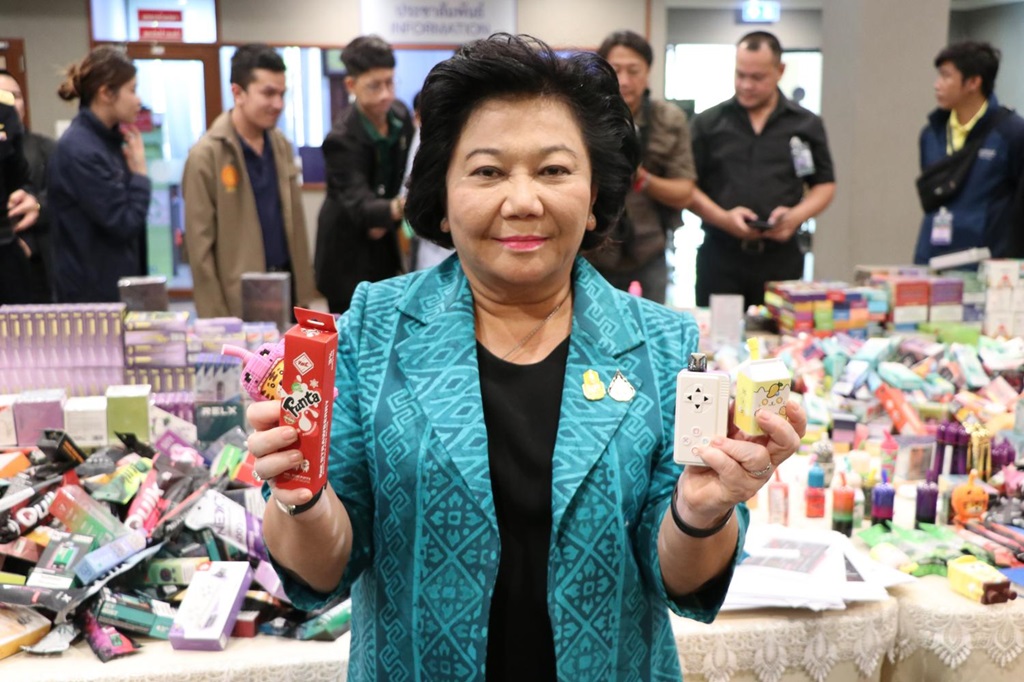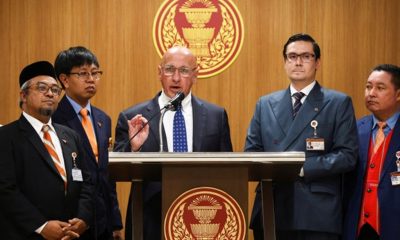Health
Children in Thailand Being Enticed into Vaping With Toy Pods

Thailand’s Consumer Protection Police Division (CPPD) is requesting a coordinated effort to safeguard adolescents from the detrimental effects that toy pods, vapers and e-cigarettes pose to children’s health.
Thailand’s Consumer Protection Police stated that in order to educate young people about the health dangers associated with vaping, educators, school personnel, parents of young cVendors hildren, and their relatives must collaborate.
It is probable that they will face criminal prosecution in Thailand for violating the laws that prohibit the sale and possession of such devices, according to CPPD chief Pol Maj Gen Wittaya Sriprasert.
He stated that the number of cases involving illicit possession and/or sale of e-cigarettes and/or their cartridges has increased in recent years, citing CPPD data.
Authorities seized toy pods and e-cigarettes from 31 vendors in 2022 for a total value of two million baht. A year ago, they seized electronic cigarettes and cartridges valued at 10.14 million baht from 25 vendors.
He stated that CPPD officials have seized toy pods, e-cigarettes and vape cartridges worth 2.7 million baht in 42 cases as of this month.
Saturday marked the most recent apprehension of two suspected of selling toy pods and e-cigarettes along Sukhumvit Road in the Watthana district of Bangkok.The suspects were apprehended with an extensive quantity of electronic cigarettes and vapers, Pol Maj Gen Wittaya stated.
Despite being illegal under Thai law, the CPPD chief stated that the police have conducted an investigation into why and how e-cigarettes have gained such popularity among Thai youths in such a brief period of time.
He told Thai media that a recent study revealed that the elegant designs, extensive flavor selection, and variety offered by the devices were what initially attracted the majority of youth consumers.
He added that toy pod, e-cigarette manufacturers and retailers employing online marketing and other advertising strategies to target young people are additional factors contributing to the surge in popularity of vapes.
Additionally, the study revealed that numerous individuals perceived e-cigarettes as a cost-effective alternative to traditional cigarettes due to their reusability and lower price point, he explained. He further stated that among Thai adolescents, awareness regarding the true health consequences of e-cigarette use is relatively limited.
Doraemon Toy Pods 9000 Puffs

Toy pods, which feature an attractive and vibrant design, are the most popular products for children: Photo CTNNews
Toy pods resemble adorable figurines so closely that they are nearly unrecognizable as electronic cigarettes. They may appear innocuously endearing, featuring an assortment of enticing flavors and vibrant hues reminiscent of cartoons.
E-cigarettes have gained widespread usage in Thailand, notwithstanding the fact that they pose a legal ban and elevate the risk of developing respiratory disease.
To appear harmless to vulnerable targets, particularly adolescents, the playful designs of the nicotine vaping devices, nicknamed “toy pods,” appear to convey the devices’ status as smoke-free, fashionable, and socially acceptable alternatives.
Particularly the additives and nicotine, the World Health Organization (WHO) has confirmed that the compounds in electronic cigarettes are hazardous and toxic. Highly addictive is nicotine, the primary component of both tobacco cigarettes and electronic cigarettes.
Nicotine use during childhood and adolescence has significant implications for cognitive development and may contribute to the development of anxiety and learning disorders. However, the e-cigarette industry specifically targets the youth demographic.
The secretary-general of the Thailand Youth Institute, Patcharapan Prajuablap, stated that a recent assault on e-cigarette shops in the Ratchadaphisek neighborhood of the Din Daeng district provided conclusive proof that the e-cigarette industry generates substantial revenue.
According to an investigation by the institute, a 20-square-meter store could generate up to one million baht per month, with 70% of its customers being minors.
4th Graders Using Toy Pods
More than half of the 43% students aged 10 and older (grades 4 to 6) who had experimented with toy pods: Photo CTNNews
The study also revealed that the busiest sales hours are from 2:00 to 6:00 pm, when students have left for the day. Toy pods, which feature an attractive and vibrant design, are the most popular products during this period. A single toy capsule contains 5,000 puffs.
Mr. Patcharapan asserts that Bangkok is home to over a thousand e-cigarette establishments, the majority of which are situated in close proximity to educational institutions; the closest is merely 130 meters from a neighborhood school.
Additionally, Bangkok has the greatest rate of teen e-cigarette use, according to the study (32.3%). As opposed to submitting orders online, these children reportedly purchased the toy pods from the stores.
“We have found that e-cigarette vendors have been trying to target young customers by offering options of flavours they like, such as Nong Pho [a Thai milk brand], Milo and Ovaltine,” he reported.
“Worse, the manufacturers and sellers even use toy marketing in advertising the e-device to create the image that the product is not dangerous to children.”
According to Mr. Patcharapan, every electronic cigarette product sold in Thailand is produced in neighboring nations.
Therefore, enhancing the efficacy of customs inspections conducted on international cargo represents the most effective approach to avert the issue.
Thailand has prohibited the import of electronic cigarettes since 2014, according to Prime Minister and Finance Minister Srettha Thavisin, who stated this recently.
“The Prime Minister should direct the Department of Customs to implement measures to prevent the smuggling of electronic cigarettes in. “It is improbable that the ongoing cat-and-mouse will resolve the issue,” he further stated.
Vaping made them feel cool

Dr. Roengrudi Pathavanich said young students were reported to have said vaping with toy pods made them feel cool: Photo CTNNews
A year ago, in collaboration with the Department of Health Service Support of the Ministry of Public Health, the institute surveyed Thai adolescents regarding the use of electronic cigarettes. 25% of the 61,688 participants, who had an average age of 15, reported using vaping devices.
Moreover, compared to the group that did not reside in a smoking environment, young people who shared an environment with e-cigarette consumers were 1.3 times more likely to develop the habit.
Children who were unaware of the risks associated with e-cigarettes were 1.14 times more likely to begin using them.
A lecturer in the Faculty of Medicine at Ramathibodi Hospital, Dr. Roengrudi Pathavanich, stated that her team conducted a study at two primary schools in Lop Buri and Tak at the beginning of this year and were astounded by their findings.
She reported that more than half of the 43% students aged 10 and older (grades 4 to 6) who had experimented with electronic cigarettes were female. 22% of students in Tak who are the same age have utilized electronic cigarettes.
According to reports, the students stated that using e-cigarettes made them feel cool and that they did not consider them to be hazardous.
A quarter (20%) of these students indicated that social media served as an inspiration, whereas 23% said they acquired their e-cigarette from a family member.
Additionally, Dr. Roengrudi stated that her prior research revealed that the mean age at which children began smoking cigarettes was eighteen years, with less than five percent beginning the habit in elementary school.
Children who use e-cigarettes are five times more likely to switch to traditional cigarettes, according to the study. This suggests that e-cigarettes serve as an entryway to combustible cigarettes.
“The number is absolutely terrifying; child protection is required immediately.” “Strict enforcement of the ban on e-cigarette sales in the country by the government is imperative,” she stated. “Otherwise, it will send the wrong message to children that the product is safe and good for use.”
Health
Report Causes Pfizer Stock to Climb Approximately $1 Billion Acquired by Starboard

(VOR News) – According to a rumor that activist investor Pfizer Starboard Value has taken a holding in the struggling pharmaceutical business that is expected to be worth around one billion dollars, the stock of Pfizer (PFE) is on the increase in premarket trading on Monday.
This comes after the report was made public. The report was made available to the general public following this. Starboard Value was successful in moving forward with the acquisition of the position.
Starboard is said to have approached Ian Read, a former chief executive officer of Pfizer, and Frank D’Amelio, a former chief financial officer, in order to seek assistance with its goals of boosting the performance of the company, according to the Wall Street Journal. Read and D’Amelio are both former Pfizer executives.
The purpose of this is to facilitate the accomplishment of its objectives, which include enhancing the overall performance of the firm.
In their previous jobs, D’Amelio and Read were chief financial officers.
It is stated in the report that the hedge fund is of the opinion that Pfizer, which is currently being managed by Albert Bourla, who succeeded Read as Chief Executive Officer (CEO) in 2019, does not demonstrate the same level of mergers and acquisitions (M&A) discipline that Read did. Bourla took over for Read in 2019. Read was succeeded by Bourla in the year 2019.
Pfizer, a multinational pharmaceutical conglomerate, has made substantial investments in the acquisition of more companies that are involved in the research and development of cancer medicines.
These businesses have been acquired for billions of dollars. The biotechnology company Seagen, which was acquired by Pfizer in the previous year for a price of $43 billion, is included in this category. One of the businesses that can be classified as belonging to this category is Seagen.
In spite of the fact that the S&P 500 Index experienced a 21% increase in 2024.
No major trading occurred in Pfizer stock that year.
Due to the fact that the demand for Pfizer’s COVID-19 vaccines fell after the firm reached its pandemic peak in 2021, the share price of the corporation has decreased by over fifty percent since that time.
This drop has occurred ever since the company’s shares reached their maximum peak, which was during the time that this decline occurred. Not only have they not changed at all, but they have also remained essentially stable. This is in contrast to the S&P 500, which has gained 21% since the beginning of this year.
Recently, the corporation was forced to take a hit when it decided to recall all of the sickle cell illness medications that it had distributed all over the world.
Fears that the prescription could lead patients to experience severe agony and possibly even death were the impetus for the decision to recall the product. In spite of the fact that Pfizer’s stock is increasing by almost three percent as a result of the news that followed the company’s decision, this is the circumstance that has come about.
SOURCE: IPN
SEE ALSO:
New Study Reveals Drinking Soda Pop Increases the Risk of Stroke
The Mpox Vaccine’s Protection Decreases Within a Year; Booster Requirements
Health
New Study Reveals Drinking Soda Pop Increases the Risk of Stroke

A recent report from global research indicates that excessive consumption of coffee or soda pop is associated with an increased risk of stroke, although the intake of black and green tea is correlated with a reduced risk. Excessive consumption of soda pop or coffee warrants caution!
Recent research indicates that it may substantially elevate the risk of stroke.
Consuming four cups of coffee daily elevates the risk of stroke, according to studies, although ingesting 3-4 cups of black or green tea daily typically offers protection against stroke. Additionally, consume more coffee; it may reduce your risk of mortality.
Recent findings from global research studies co-led by the University of Galway and McMaster University, alongside an international consortium of stroke researchers, indicate that soda, encompassing both sugar-sweetened and artificially sweetened variants such as diet or zero sugar, is associated with a 22 percent heightened risk of stroke. The risk escalated significantly with the consumption of two or more of these beverages daily.
Stroke Risk Fizzy Drinks and Soda Pop
The correlation between fizzy drinks consumption and stroke risk was most pronounced in Europe, the Middle East, Africa, and South America. Women exhibit the most elevated risk of stroke from bleeding (intracranial hemorrhage) associated with fruit juice beverages. Consuming over 7 cups of water daily diminishes the likelihood of stroke due to a clot.
Researchers observed that numerous items advertised as fruit juice are derived from concentrates and have added sugars and preservatives, potentially negating the advantages often associated with fresh fruit and instead elevating stroke risk.
Fruit juice beverages were associated with a 37 percent heightened risk of stroke resulting from bleeding (intracranial hemorrhage). Consuming two of these beverages daily increases the risk thrice.
Consuming over four cups of coffee daily elevates the risk of stroke by 37 percent, although lower consumption levels do not correlate with stroke risk. Conversely, tea consumption was associated with an 18-20 percent reduction in stroke risk. Additionally, consuming 3-4 cups daily of black tea, such as Breakfast and Earl Grey varieties, excluding green and herbal teas, was associated with a 29 percent reduced risk of stroke.
Consuming 3-4 cups of green tea daily was associated with a 27 percent reduction in stroke risk. Notably, the addition of milk may diminish or inhibit the advantageous effects of antioxidants present in tea. The lower risk of stroke associated with tea consumption was negated for individuals who added milk.
Disclaimer: This article is intended solely for informational reasons and should not be considered a replacement for professional medical counsel. Consistently consult your physician regarding any inquiries pertaining to a medical problem.
Related News:
Starbucks Faces Sales Decline Amid Price Fatigue and Rising Competition
Starbucks Faces Sales Decline Amid Price Fatigue and Rising Competition
Health
Following a Diagnosis of Breast Cancer, What Else Should You Know?

(VOR News) – Even though breast cancer affects one in eight American women, receiving a diagnosis can make a woman feel isolated.
Experts in breast cancer from the American College of Physicians (ACS) advise patients on how to manage their disease so that they may better cope with this awful information.
First, the kind and stage of breast cancer dictates the course of your care.
In addition to immunotherapy and chemotherapy, there are various surgical options available for the treatment of breast cancer.
Women of African descent are disproportionately affected by triple-negative breast cancer, an extremely aggressive form of the disease that has never proven easy to treat.
According to the American Cancer Society, pembrolizumab (Keytruda), an immunotherapy, has been shown to be helpful when combined with chemotherapy and is currently the recommended course of treatment for certain combinations of triple-negative breast cancer.
In her presentation, Dr. Katharine Yao said, “It’s really important that the patient and physician discuss the patient’s preferences and values when deciding what type of treatment to pursue and that they have an honest, individualized discussion with their care team.”
She is currently responsible for developing breast cancer treatment recommendations for more than 575 hospitals and institutions nationwide in her role as chair of the American College of Surgeons’ National Accreditation Program for Breast Institutions (NAPBC).
Yao, vice chair of research at Endeavor Health NorthShore Hospitals in New York, pointed out that each decision made about a patient’s treatment plan should take her preferences and diagnosis into consideration.
She ought to think about whether she would prefer a mastectomy—a surgical procedure that involves removing the entire breast with or without reconstruction—or a lumpectomy, which involves a surgical procedure that spares part of the breast tissue.
She stated that “the breast cancer you have may be very different from the breast cancer you hear about in your neighbor, colleague, or friend” in a press release issued by the American Cancer Society (ACS).
“Consider that while discussing breast cancer with others.”
Throughout your journey, it is critical that you look after your emotional health because having breast cancer may have a detrimental impact on your mental health.
“Getting a cancer diagnosis does not mean that everything in your life stops to be normal.” Director of the Fellowship in the Diseases of the Breast program at the Winthrop P. Rockefeller Cancer Institute at the University of Arkansas and state head of the American Cancer Society Commission on Cancer for Arkansas, Dr. Daniela Ochoa She thinks adding the burden of a cancer diagnosis and treatment to all the other pressures in life may be taxing.
“Managing stress and emotional health is vital component of a treatment plan.”
Ochoa recommends clinically trained psychologists and social workers who have assisted people in coping with cancer to anyone receiving treatment. Learning coping techniques might also be facilitated by joining cancer support groups or cancer wellness initiatives.
Breast cancer specialists say your care team is crucial.
The American Cancer Society (ACS) defines comprehensive care as having support at every stage of the procedure from surgeons, oncologists, patient navigators, nurses, social workers, psychologists, and other specialists.
After receiving a breast cancer diagnosis, women should see a surgeon or medical oncologist to explore their options; nevertheless, treatment shouldn’t be discontinued after just one appointment or after surgery is over.
Additionally, you can ask trustworthy friends or family members to accompany you to appointments and aid you with research or notes. They could serve as a network of support for you.
Yao stated in his talk that “one of the most important things is that patients should search out a team they have confidence in, that they trust will have their back when they need it, and a team they feel they can get access to and that will help them when they are in need.”
SOURCE: MP
SEE ALSO:
The Mpox Vaccine’s Protection Decreases Within a Year; Booster Requirements
COVID was a Paradigm Shift in Health Policymaking, Says Commissioner Stella Kyriakides.
Rwanda Reports 8 Deaths Linked To Ebola-Like Marburg Virus Days After It Declared An Outbreak
-

 News3 years ago
News3 years agoLet’s Know About Ultra High Net Worth Individual
-
Entertainment1 year ago
Mabelle Prior: The Voice of Hope, Resilience, and Diversity Inspiring Generations
-

 Health3 years ago
Health3 years agoHow Much Ivermectin Should You Take?
-

 Tech2 years ago
Tech2 years agoTop Forex Brokers of 2023: Reviews and Analysis for Successful Trading
-

 Lifestyles2 years ago
Lifestyles2 years agoAries Soulmate Signs
-

 Health2 years ago
Health2 years agoCan I Buy Ivermectin Without A Prescription in the USA?
-

 Movies2 years ago
Movies2 years agoWhat Should I Do If Disney Plus Keeps Logging Me Out of TV?
-

 Learning2 years ago
Learning2 years agoVirtual Numbers: What Are They For?












